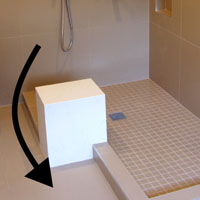WALL TILES ON THE FLOOR
Can you use wall tiles on your floor?
Find out below.
Or did you want to read my other article on using floor tile on walls?
Using Wall Tiles On Your Floor
The short answer: Using wall tiles on your floor isn't recommended. But it can be done.
The long answer: Much of the tile on the market can be used on both floors and walls. The disadvantages of using wall tiles on your floor is lack of surface durability, slip resistance and hardness while also potentially being more absorbent.
The long answer: Much of the tile on the market can be used on both floors and walls. The disadvantages of using wall tiles on your floor is lack of surface durability, slip resistance and hardness while also potentially being more absorbent.
Surface Durability
The technical measurement for durability is the Porcelain Enamel Institute Rating or PEI Class. In short they are:
- PEI Class 1: No foot traffic - Use this tile on your walls
- PEI Class 2: Light foot traffic - Use this tile on your walls and on floors where traffic is light and you use soft footwear.
- PEI Class 3: Light to moderate traffic - Use this tile on floors with normal foot traffic or use it on countertops or walls.
- PEI Class 4: Moderate to heavy traffic - Use this tile on floors with heavier traffic like commercial workplaces. Also can be used in the above PEI Class cases.
- PEI Class 5: Heavy to extra traffic - Use this tile on floors with heavy traffic such as commercial or institutional walkways. Also can be used in the above PEI Class cases.
Slip Resistant
While PEI Class is a good test for whether tile is appropriate on your floors, it does not take into account friction—or slip resistance. That is measured by Dynamic Coefficient of Friction or DCOF. DCOF measures the resistance one encounters when already in motion.
The standard for floor tile is a DCOF of 0.42.
That means, if the wall tile you want to install on your floor has a DCOF of less than 0.42, it will probably be quite slippery when wet.
The standard for floor tile is a DCOF of 0.42.
That means, if the wall tile you want to install on your floor has a DCOF of less than 0.42, it will probably be quite slippery when wet.
Surface Hardness
Hardness of tile is measured by a MOHS scale named after the German geologist Friedrich Mohs who created the scale. Hardness is measured as follows:
Each level is in the MOHS scale is 10 times harder than the previous level.
Porcelain tile often has a rating of 7, 8 or 9 while other less hard tiles can be rated a 5 or 6.
- Talc
- Gypsum also your fingernails
- Calcite also a penny
- Fluorite
- Apatite also a knife blade
- Feldspar
- Quartz
- Topaz
- Corundum
- Diamond
Each level is in the MOHS scale is 10 times harder than the previous level.
Porcelain tile often has a rating of 7, 8 or 9 while other less hard tiles can be rated a 5 or 6.
Water Absorption
The water absorption qualities of tile can also be measured. The categories are:
Porcelain tile is generally impervious while travertine would be more absorbent, around 2.5% of its body weight.
- Non-vitreous - Tile with water absorption of more than 7% of its body weight.
- Semi-vitreous - Tile with water absorption of more than 3% but less than 7% of its body weight.
- Vitreous - Tile with water absorption of more than 0.5% but less than 3% of its body weight.
- Impervious - Tile with water absorption of less than 0.5% of its body weight.
Porcelain tile is generally impervious while travertine would be more absorbent, around 2.5% of its body weight.
Summary
While surface durability, slip resistance, surface hardness and water absorption are important, use your powers of observations to take another look.
Is the tile so thin that it might crack under pressure? If so, don't use it on your floors. Does the tile have intricate designs or a coarse surface? That surface will trap dirt and make cleaning a real pain. I wouldn't suggest using it on your floors.
Hopefully the data above will help you when choosing to use wall tile on your floors. If you are ready to hire Tile Plus to install the tile on your floors. Then visit our services page linked below.
Is the tile so thin that it might crack under pressure? If so, don't use it on your floors. Does the tile have intricate designs or a coarse surface? That surface will trap dirt and make cleaning a real pain. I wouldn't suggest using it on your floors.
Hopefully the data above will help you when choosing to use wall tile on your floors. If you are ready to hire Tile Plus to install the tile on your floors. Then visit our services page linked below.
PO Box 54333,
San Jose,
CA
95154
408-938-3494





